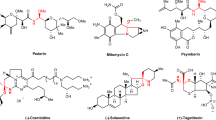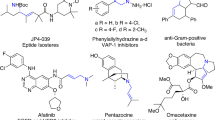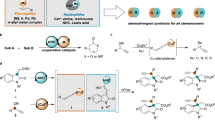Abstract
Construction of the hydroquinoline skeleton of symbioimine by Cu-mediated N-alkenylation or O-alkenylation of an allyl aminoalcohol, in which either chemoselectivity could lead to the target compound, was investigated. O-alkenylation followed by Claisen rearrangement was favored with high selectivity under a ligand-free condition. Subsequent intramolecular condensation furnished the hydroquinoline skeleton of symbioimine.
Similar content being viewed by others
Introduction
In 2004, Uemura and coworkers reported the isolation of symbioimine (1) (Scheme 1) from dinoflagellate Symbiodinium sp. having a symbiotic relationship with Amphiscolops sp.1. Symbioimine (1) inhibits osteoclastogenesis in RAW264 cells (EC50 = 44 μM) without showing toxicity (100 μg/mL)1,2,3. It also shows cyclooxygenase-2 (COX-2) inhibitory activity (10 uM)2,3. These biological activities suggest its application for antiresorptive and anti-inflammatory agents. Symbioimine (1) possesses a tricyclic skeleton with an aromatic substituent, in which an iminium cation and a sulfonium anion form a zwitterionic pair. While several research groups have reported the synthesis of 1, all syntheses employed an intramolecular Diels–Alder reaction of dienes possessing an aromatic substituent for the construction of the skeleton4,5,6,7,8,9,10, based on the proposed biosynthesis by Uemura3. However, this approach is not amenable to the syntheses of derivatives of 1 such as those with different aromatic groups for the improvement of the pharmacological activity, since the aromatic substituent was introduced at the early stage of the syntheses before the construction of the tricyclic core. Despite the attractive biological activities, the structure–activity relationship of 1 has not been elucidated. We planned a new synthetic approach for the synthesis of 1 as well as derivatives with different aromatic substituents, in which the aromatic rings are introduced at the late stage of the synthesis after the construction of the tricyclic core 2 (Scheme 1). Toward the synthesis, we devised a route to construct the hydroquinoline moiety of 2 by the coupling between iodocyclohexene 3 and allyl aminoalcohol 4 (Scheme 1). The Cu-mediated N-alkenylation11,12,13 to enamine 5 followed by a substitution reaction was expected to afford the hydroquinoline skeleton 6 (Scheme 2). However, Cu-mediated O-alkenylation could compete with N-alkenylation12,14,15,16,17. Generally in a chemoselective coupling reaction with a substrate having two reactive sites, one coupling with one site affords the desired product, while another coupling with another site does not lead to the desired product. Therefore, the success of the synthesis is dependent on the achievement of the desired chemoselectivity. In our planned synthesis, however, the O-alkenylation to 7 followed by Claisen rearrangement18 to 8 and condensation was also expected to afford the desired hydroquinoline skeleton 6 (Scheme 2). Thus, either chemoselectivity is acceptable to furnish the target compound, namely, we have devised a chemoselectivity-independent approach. To verify this concept, we investigated the synthesis of the hydroquinoline skeleton 6 of symbioimine (1) through the Cu-mediated coupling of alkenyl iodide 3a and allyl aminoalcohol 4a.
Results and discussion
Sulfonamide 4aa (R = Ts) of the allyl aminoalcohol was chosen as the coupling partner owing to the stability of the target enamine, which was prepared according to the literature from ethyl 2-(hydroxymethyl)-2-propenoate in three steps19,20. While Cu-catalyzed selective N-arylation or O-arylation conditions of aminoalcohols have been reported to date12,14,15,16,17, a selective arylation or alkenylation between sulfonamides and alcohols has not been investigated. After initial screening of the coupling conditions between alkenyl iodide 3a and sulfonamide 4aa, CuI (1.0 eq.) and N,N′-dimethylethylenediamine (2.0 eq.) were employed, and bases (2.5 eq.) and solvents were screened under reflux conditions for 19–24 h with 2.0 eq. of 3a (Table 1)21,22,23. In entry 1 using K3PO4 in CH3CN, a mixture of enamine 5a through N-alkenylation, ketone 8a through O-alkenylation followed by Claisen rearrangement, imine 9a through N-alkenylation followed by aza-Claisen rearrangement, and several products through both N- and O-alkenylations and Claisen rearrangements were obtained. The yields of 5a, 8a, and 9a were 14%, 23%, and 7% with recovery of 49% of 4aa, respectively. In entries 2–5, KOtBu, CsOAc, K2CO3, and Cs2CO3 were used as bases in CH3CN. In entry 5 using Cs2CO3, the yield of 5a and the chemoselectivity were slightly improved, giving 5a in 26% yield. In entries 6–8, DMF, DMSO, and toluene were used as solvents. However, the yield of 5a and the chemoselectivity were not improved. Despite the low yield, enamine 5a was converted to hydroquinoline 6a in 26% yield by an acid-catalyzed substitution reaction24 (Scheme 3).
Although the target hydroquinoline skeleton was constructed, the yield of 6a was too low for application to the synthesis of symbioimine (1). The primary problem was the poor selectivity and yield of the coupling between 3a and 4aa. Buckwald et al. reported that an electron-rich anionic ligand and an electron-poor neutral ligand favored N-arylation and O-arylation, respectively, but the ligand-assisted conditions were not effective for coupling chelating aminoalcohols with fewer methylene groups14. Instead, it was reported that ligand-free conditions were effective for selective N-arylation of chelating aminoalcohols, in which the selectivity depended on the solvent14,15. Buckwald et al. reported the selective N-arylation of ethanolamine in DMF and 3-piperidinol in CH3CN in 40:1–25:1 ratios and the O-arylation of 3-amino-1-propanol in toluene and 3-piperidinol in THF in a 1:2 ratio14. Chan et al. also reported that N- and O-arylations of 3-amino-1-propanol occurred in DMF with a 13:3 ratio and in toluene with a 4:15 ratio15. Thus, we investigated the coupling of 3a and 4aa under ligand-free conditions in several solvents (Table 2). In CH3CN (entry 1), surprisingly, ketone 8a through O-alkenylation followed by Claisen rearrangement was selectively obtained in 67% yield. In DMF (entry 2) or toluene (entry 3), the yield of 8a significantly decreased to 26% and 9%. In DMSO (entry 4) or THF (entry 5), 8a was not formed and 5 was produced in 12% and 19% yields. The coupling between 3a and 4ab (R = Ns) in CH3CN afforded 8b in 70% yield (entry 6). Under all conditions, enol ether 7 through O-alkenylation was not observed. Density functional theory (DFT) calculations at the PBE0/6–31 + G(d) level of theory showed that the activation barrier for the Claisen rearrangement is 23.4 kcal/mol and ketone 8 (R = SO2Ph) is 21.1 kcal/mol more stable than 7, which is consistent with the experimental results. It is noteworthy that our observed solvent effect on the selectivity of coupling for the sulfonamides of the aminoalcohol was opposite to the reported ones for aminoalcohols and the highly selective O-alkenylation was achieved. Since selective O-arylation of chelating aminoalcohols had been an unsolved problem14,15, the generality of our result is of great interest. With the selective O-alkenylation condition in hand instead of N-alkenylation, ketone 8b was converted to hydroquinoline 6b (Scheme 4). Deprotection of the o-nitrobenzenesulfonyl group of 8b by PhSH and K2CO325 followed by spontaneous intramolecular condensation furnished hydroquinoline 6c. Since 6c was not isolated by silica gel column chromatography owing to the instability to the acidic condition, 6c was converted to amide, giving hydroquinoline 6b in 96% yield (2 steps).
Conclusions
In summary, construction of the hydroquinoline skeleton of symbioimine was investigated by a chemoselectivity-independent approach employing Cu-mediated N-alkenylation or O-alkenylation of sulfonamides of an allyl aminoalcohol. While N-alkenylation took place in low yield with poor selectivity under ligand-assisted conditions, high yield and selectivity for O-alkenylation followed by Claisen rearrangement were achieved with a ligand-free condition. Both products through N- and O-alkenylation were converted to the target hydroquinoline skeleton. This approach was proven to be promising to synthesize the target skeleton and its application to the synthesis of symbioimine is in progress. In addition, the generality of the selective O-alkenylation condition to various aminoalcohols bearing sulfonamide, amide, and carbamate is currently under investigation in our laboratory.
Methods
General procedure of Cu-mediated N- and O-alkenylation (Tables 1 and 2)
Copper iodide (CuI) was prepared according to the literature procedure26. Purified CuI (38 mg, 0.20 mmol) was suspended in anhydrous solvent (0.10 mL) under an argon atmosphere. Under the conditions in Table 1, N,N′-dimethylethylenediamine (45 μL, 0.40 mmol) was added to the suspension. To the solution, sulfonamide 4aa or 4ab (0.20 mmol) in anhydrous solvent (0.10 mL), base (0.50 mmol), and vinyl iodide 3a (83 mg, 0.40 mmol) were added at 0 °C. The reaction mixture was stirred under heating for 19–24 h. The reaction mixture was cooled to room temperature and quenched by addition of saturated NH4Cl aq. (0.5 mL). The organic layer was separated, and the aqueous layer was extracted with EtOAc (1.0 mL) three times. The combined organic layer was washed with brine, dried over Na2SO4, and filtered through a cotton plug. The filtrate was concentrated in vacuo, and the residue was purified by silica gel column chromatography with hexane/EtOAc (10/1 to 5/1) to isolate 5, 8 and 9.
References
Kita, M. et al. Symbioimine exhibiting inhibitory effect of osteoclast differentiation, from the symbiotic marine dinoflagellate Symbiodinium sp. J. Am. Chem. Soc. 126, 4794–4795 (2004).
Kita, M. & Uemura, D. Iminium alkaloids from marine invertebrates: Structure, biological activity, and biogenesis. Chem. Lett. 34, 454–459 (2005).
Kita, M. et al. Symbioimine and neosymbioimine, amphoteric iminium metabolites from the symbiotic marine dinoflagellate Symbiodinium sp. Bioorg. Med. Chem. 13, 5253–5258 (2005).
Varseev, G. N. & Maier, M. E. Total synthesis of (±)-symbioimine. Angew. Chem. Int. Ed. 45, 4767–4771 (2006).
Sakai, E., Araki, K., Takamura, H. & Uemura, D. Stereoselective construction of the octalin unit of symbioimine using an intramolecular Diels–Alder reaction. Tetrahedron Lett. 47, 6343–6345 (2006).
Zou, Y., Che, Q. & Snider, B. B. Total synthesis of (±)-symbioimine. Org. Lett. 8, 5605–5608 (2006).
Kim, J. & Thomson, R. J. Enantioselective total synthesis of the osteoclastogenesis inhibitor (+)-symbioimine. Angew. Chem. Int. Ed. 46, 3104–3106 (2007).
Born, S., Bacani, G., Olson, E. & Kobayashi, Y. Microwave-assisted intramolecular Diels–Alder reaction towards the total synthesis of symbioimine. Synlett 2008, 2877–2881 (2008).
Burke, J. P., Sabat, M., Iovan, D. A., Myers, W. H. & Chruma, J. J. Exploring the original proposed biosynthesis of (+)-symbioimine: Remote exocyclic stereocontrol in a type I IMDA reaction. Org. Lett. 12, 3192–3195 (2010).
Xiang, M., Wu, Y., Burke, J. P. & Chruma, J. J. High π-facial and exo-selectivity for the intramolecular Diels–Alder cycloaddition of dodeca-3,9,11-trien-5-one precursors to 2-epi-symbioimine and related compounds. J. Org. Chem. 81, 8508–8519 (2016).
Ley, S. V. & Thomas, A. W. Modern synthetic methods for copper-mediated C(aryl)-O, C(aryl)-N, and C(aryl)-S bond formation. Angew. Chem. Int. Ed. 42, 5400–5449 (2003).
Sambiagio, C., Marsden, S. P., Blacker, A. J. & McGowan, P. C. Copper catalysed Ullmann type chemistry: From mechanistic aspects to modern development. Chem. Soc. Rev. 43, 3525–3550 (2014).
Bhunia, S., Pawar, G. G., Kumar, S. V., Jiang, Y. & Ma, D. Selected copper-based reactions for C-N, C–O, C–S, and C–C bond formation. Angew. Chem. Int. Ed. 56, 16136–16179 (2017).
Shafir, A., Lichtor, P. A. & Buchwald, S. L. N- versus O-arylation of aminoalcohols: orthogonal selectivity in copper-based catalysts. J. Am. Chem. Soc. 129, 3490–3491 (2007).
Chang, J. W. W. et al. Copper-catalyzed Ullmann coupling under ligand- and additive- free conditions. Part 1: O-arylation of phenols with aryl halides. Tetrahedron Lett. 49, 2018–2022 (2008).
Jones, G. O., Liu, P., Houk, K. N. & Buchwald, S. L. Computational explorations of mechanisms and ligand-directed selectivities of copper-catalyzed Ullmann-type reactions. J. Am. Chem. Soc. 132, 6205–6213 (2010).
Yu, H.-Z., Jiang, Y.-Y., Fu, Y. & Liu, L. Alternative mechanistic explanation for ligand-dependent selectivities in copper-catalyzed N- and O-arylation reactions. J. Am. Chem. Soc. 132, 18078–18091 (2010).
Nordmann, G. & Buchwald, S. L. A domino copper-catalyzed C–O coupling−Claisen rearrangement process. J. Am. Chem. Soc. 125, 4978–4979 (2003).
Žukauskaitė, A. et al. Synthesis of 1,5-diazaspiro[2.3]hexanes, a novel diazaspirocyclic system. Tetrahedron 69, 3437–3443 (2013).
Tsukamoto, H., Kawase, A. & Doi, T. Palladium-catalyzed umpolung type-II cyclization of allylic carbonate-aldehydes leading to 3-methylenecycloalkanol derivatives. Adv. Synth. Catal. 361, 3733–3738 (2019).
Yamada, K., Kubo, T., Tokuyama, H. & Fukuyama, T. A mild copper-mediated intramolecular amination of aryl halides. Synlett 2002, 0231–0234 (2002).
Kubo, T. et al. A mild inter- and intramolecular amination of aryl halides with a combination of CuI and CsOAc. Tetrahedron 64, 11230–11236 (2008).
Wang, X. et al. Copper-catalyzed N-arylation of sulfonamides with aryl bromides under mild conditions. Tetrahedron Lett. 53, 7–10 (2012).
Emer, E. et al. Direct nucleophilic SN1-type reactions of alcohols. Eur. J. Org. Chem. 2011, 647–666 (2011).
Fukuyama, T., Jow, C.-K. & Cheung, M. 2- and 4-Nitrobenzenesulfonamides: Exceptionally versatile means for preparation of secondary amines and protection of amines. Tetrahedron Lett. 36, 6373–6374 (1995).
Dieter, R. K., Silks, L. A., Fishpaugh, J. A. & Kastner, M. E. Control of chemo- and stereoselectivity in the reactions of organocuprates with .alpha.-oxoketene dithioacetals. J. Am. Chem. Soc. 107, 4679–4692 (1985).
Acknowledgements
This work was supported by JSPS KAKENHI Grant Nos. JP20K05499 (S.H.) and JP21J14458 (R.F.), and funds from the Fukuoka Naohiko Memorial Foundation (S.H.).
Author information
Authors and Affiliations
Contributions
S.H., T.S., and K.H. designed and organized the project. R.F. conducted the experiments. All authors contributed the writing of the manuscript.
Corresponding author
Ethics declarations
Competing interests
The authors declare no competing interests.
Additional information
Publisher's note
Springer Nature remains neutral with regard to jurisdictional claims in published maps and institutional affiliations.
Supplementary Information
Rights and permissions
Open Access This article is licensed under a Creative Commons Attribution 4.0 International License, which permits use, sharing, adaptation, distribution and reproduction in any medium or format, as long as you give appropriate credit to the original author(s) and the source, provide a link to the Creative Commons licence, and indicate if changes were made. The images or other third party material in this article are included in the article's Creative Commons licence, unless indicated otherwise in a credit line to the material. If material is not included in the article's Creative Commons licence and your intended use is not permitted by statutory regulation or exceeds the permitted use, you will need to obtain permission directly from the copyright holder. To view a copy of this licence, visit http://creativecommons.org/licenses/by/4.0/.
About this article
Cite this article
Fujita, R., Hanaya, K., Sugai, T. et al. Chemoselectivity-independent Cu-mediated coupling to construct the hydroquinoline skeleton of symbioimine. Sci Rep 11, 24078 (2021). https://doi.org/10.1038/s41598-021-03448-9
Received:
Accepted:
Published:
DOI: https://doi.org/10.1038/s41598-021-03448-9
Comments
By submitting a comment you agree to abide by our Terms and Community Guidelines. If you find something abusive or that does not comply with our terms or guidelines please flag it as inappropriate.







